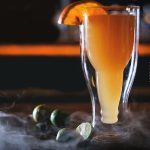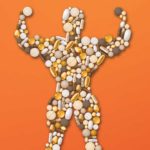Flock Theory and the Synchronies of Nature
What theoretical physics teaches us about the fish and fowl that collectively take our breath away by moving in such elegant formations
 Priyanka Pulla
Priyanka Pulla
 Priyanka Pulla
|
23 Feb, 2012
Priyanka Pulla
|
23 Feb, 2012
/wp-content/uploads/2015/11/flock.jpg)
What theoretical physics teaches us about the fish and fowl that collectively take our breath away by moving in such elegant formations
Each spring, certain marshlands of Denmark are witness to a skyborne spectacle. Millions of European Starlings, a species of small bird, do a complex ballet in the sky during the evening, before settling down to roost. The internet is crawling with videos, both fake and real, of these starling flocks swooping through the sky like trained dancers at an Olympics opening ceremony. This eerie sight is called ‘sort sol’ in Danish, meaning ‘black sun’.
Such complex patterns are common across the animal kingdom—birds form flocks, animals form herds, insects form swarms, and fish form schools. When they do so, these groups are striking in their coherence, beauty and coordination. Nobody choreographs them: each acts on its own. And yet, they move with the swiftness and decisiveness of a battalion following its colonel.
These formations remain a mystery to scientists. Why do animals form such herds? How do they retain such order without an apparent leader? How do such complex patterns emerge?
Among the expected lineup of biologists, ecologists, oceanographers and others studying this phenomena is a rather unlikely group—theoretical physicists. Condensed-matter physicists, to be specific: scientists who study matter in its condensed states, such as liquids, colloids and solids, and the properties that arise from such changes in state. Most of the time, they study gases or crystals in laboratories, not seagulls and cod. Occasionally, though, their attention strays.
An ecological phenomenon begins to look rather like a collection of molecules wafting together. Thousands of birds in flight seem to swim like the particles of a fluid.
THE UNLIKELY FLOCK THEORIST
That is how Sriram Ramaswamy, a physicist at Bangalore’s Indian Institute of Science (IISc), together with his team, uncovered some novel facts about these gregarious creatures and their flock dances. The researcher is quick to deny that he has ever worked with birds, fish or stampeding wildebeest. He hasn’t
had to. His team’s work is mostly theoretical, its only experimentation being done in a laboratory on the IISc campus. From this landlocked spot, he and his team have made predictions applicable to schools of fish so large that they stretch tens of kilometres.
It all began a few years ago when Ramaswamy and colleague Aditi Simha, who is now at IIT-Madras, arrived at some interesting conclusions about how flocks would behave. Their work extended the studies of American theorists John Toner and Yuhai Tu, and was purely theoretical. They discovered that the statistical qualities of large flocks would be very different from those of normal populations. This difference was somewhat abstruse—it lay in the way the standard deviation of a sample of a flock related to its mean. The same unusual relation would not hold good, for example, for a sample population in a market survey for toothpastes.
While the prediction may seem like statistical mumbo jumbo to most lay people, when extrapolated a little, it means this: a small disturbance beginning anywhere in the flock—say, one starling is distracted and flies off in another direction—would quickly snowball into a large disturbance. Compared to a static group, the disturbance would grow much more rapidly and change the direction of the entire sub-population. This meant that the density of such a flock—the number of starlings in any cubic metre of Danish airspace, for example—would fluctuate massively.
It was an interesting finding, but Ramaswamy was looking for practical corroboration, beyond paper. So, he began scouting for ecologists who would test it. Sadly, there were no takers.
However, he had a strong hunch that maybe he did not need ecologists. Maybe, the dynamics of a fish school could be mimicked right in his lab. His plan was deviously simple and involved copper wires instead of carp. How is such a thing possible?
THE COPPER-WIRE RACETRACK
Think for a moment about logs of timber that lumberjacks drive down a river to saw-mills. When a massive collection of logs like this is spread across the surface of a wide river, the tree-trunks point in every direction—a messy, chaotic sight. Yet, when they float down to a narrow riverbend, they align themselves in the direction of the flow. Such natural order exists everywhere—in the display of your laptop’s screen where liquid crystals point in one direction. Or the domains inside a magnet.
For a moving group of oblong objects to assume such order, a few conditions must be met. The more densely packed the objects are, the more likely they are to attain order. Conversely, the fewer the units in a group, the more topsy-turvy it gets. Think a few hundred logs coursing along the widest section of the River Brahmaputra.
To a physicist’s eye, Ramaswamy says, a flock of birds is nothing but a “weird sort of orientational order”. With a little persuasion, therefore, inanimate copper wires could be made to act like fish.
The team that carried out this experiment had Ramaswamy, his student Vijay Narayan, and Narayanan Menon, a researcher from University of Amherst who was then on a sabbatical in India.
This is what they did. First they clipped copper wires into small pieces. Next, they found a vibration tester, a device often used in the packaging industry to test if a product can withstand shaking during shipping. The tester is simply a table than can toss something strapped onto it up and down—by just a fraction of a millimetre, if needed. This done, the team built a sort of circular horse-track, with walls, on the surface of the tester. The walls would ensure that the clippings, when thrown about inside the track, would travel like something of a bird flock.
Thrown forward by the jiggling table, but caged by the racetrack, the copper wires shimmy in such a lively manner, it is easy to imagine they are a group of living things—a virulent cluster of bacteria chasing a cornered cell, if you please. And yet, they are ordered.
Because of their particular shape—elongated, and with a slight difference in the shapes of their edges—each wire behaves similarly. It heads in more-or-less the same direction at almost the same angle. There are quantitative measures to calculate the orderliness of a group, and these copper wires fit the bill.
The experiment was a success. The copper wires behaved exactly like the theories predicted, down to the giant fluctuations. The implications of these findings are a little difficult to visualise. What is a giant fluctuation? How ‘giant’ is it, really? While no one will ever know unless the theories are tested directly among fish or fowl, Vishwesha Guttal, another condensed-matter physicist studying flocks (through computer simulations and not copper wires) at IISc’s Centre for Ecological Sciences, gives me an image to work with—a starling video shot over a lake in Norway.
The flock looks like a menacing, living and breathing creature. It arrives like one large nimbus cloud, but quickly parts like the Red Sea in the Biblical passage. From black, it changes colour to grey as the birds spread out thinner and thinner, until you can see the grey evening sky between them. The flock dances almost volitionally, as if putting on a show for the watching audience in a boat below.
It is such spectacular variations in density that theorists like Ramaswamy, Toner and Tu are trying to explain. Are their findings surprising? “Absolutely,” Guttal says, “You would expect that when you have a set of interacting organisms, they would have a roughly uniform density through space.”
TESTING THE THEORIES
Ramaswamy and Simha’s prediction is yet to be tested in the field, although some studies seem to support it.
In 2006, a Boston-based group of researchers, including oceanographers and ecologists, published a paper on the behaviour of large shoals of fish. Their subject was shoals containing millions of fish in the Atlantic Ocean, off the coast of Long Island, USA. Their findings, according to Ramaswamy, are reason for hope: “Some of their data is consistent with the relation between standard deviation and mean which we predict.”
Moreover, the Boston group, led by Nicholas Makris, a researcher from the Massachusetts Institute of Technology (MIT), observed ‘density waves’ travelling through shoals. A density wave is a change in density that travels through a population faster than the fish themselves can swim. Think a large traffic-jam of cars lined up bumper-to-bumper. Suppose one of them dashes into another and the slight compression among cars travels forward through the jam—this is a density wave, something Ramaswamy, Toner and Tu also speak of. However, the theorists again seem to have a hard time enticing the experimentalists. “We tried to show them our papers and induce them to test our theories, but they weren’t biting,” quips Ramaswamy.
Studies of the sort described in the Makris paper and by Ramaswamy could have implications for the way fisheries and wildlife boards operate. “They need to understand that conventional methods of measuring populations won’t work because they are too local, while a disturbance in a population can spread across a far larger region,” explains Ramaswamy.
ALGAE PREFER BREAST STROKE
Another theory of Ramaswamy, Yashodhan Hatwalne and Madan Rao of Raman Research Institute, Bangalore, and Simha found willing experimental support, though. Based on the differences between how bacteria and algae swim—the former push water back with their tails, while algae do a sort of breast stroke—the group concluded that any cluster of swimming bacteria would reduce the viscosity of the fluid it is in, while algae would increase it.
Viscosity can be thought of as the thickness of a fluid, or how difficult it is to swim through. For example, honey is more viscous than water. The group’s studies showed that a suspension of swimming bacteria would be less viscous than one with stationary bacteria. The implications? One could possibly measure the motility of sperm from the viscosity of the fluid in which they swim.
This theory attracted another group in Grenoble, France, who ran experiments on algae and confirmed the prediction. A team at Argonne National lab in the US tested the bacteria theory, which checked out too.
THE MINIMAL MODEL
All of Ramaswamy’s work and that of contemporary theorists such as Toner and Tu are just small pieces of a very large jigsaw puzzle. To truly understand flocks, a great deal of experimental data is also needed. This is hard to come by, given how difficult it is to make three-dimensional measurements of a flock moving at high speeds.
What theorists like Ramaswamy are doing is creating minimal models—the bare bones of flock dynamics. Assume no consciousness and very little communication: how would a flock behave, then, driven purely by physics? Therefore, these models work on a large scale, and often cannot explain the minutiae.
“What we are trying to understand is collective behaviour, and not necessarily every tiny detail. It’s what physicists do,” says Ramaswamy.
Further, their models work across species. Madan Rao, for example, studies flocks within cells—specifically, cytoskeletal structures. The equations, it turns out, are the same.
IMPLICATIONS BEYOND THE LAB
Does it really help to know that a flock of birds or swarm of locusts is going to see massive fluctuations as it travels? What is all this in aid of? Explains Guttal, whose research interest is evolutionary biology: “While the fluctuations may be a result of some physical laws, they may have consequences for the fitness of the animal.”
What he is saying is simple. In the process of evolution, certain traits survive from one generation to the next because they allow an animal to give birth to more offspring. Tigers developed stripes because it helped camouflage them. Female baboons developed bright red rumps because it attracted partners. However, when these mutations first occurred, they were random and pointless. A tiger just happened to be born striped, but evolution quickly favoured it over the rest because the striped tiger survived far longer than its plain cousins.
While every physical trait we possess need not serve an evolutionary purpose, there is a good chance it might. And so, if a fish school fluctuates in such a spectacular manner, some biologists believe it may be advantageous. To take a guess, such variations may help the fish evade predators better, or find food more effectively. “We don’t know yet,” says Guttal, “but that is a possibility we look for.”
The study of flocks, schools, herds and swarms has already yielded much of interest to mankind. In Switzerland, researchers have built an army of flying robots that mimic the dynamics of flocks. These could be the basis for next-generation military drones. The so-called ‘ant colony algorithm’, an important computational model that can be used to find the best route to a point, is a direct result of flock studies. The way human crowds behave can also be understood through the study of animal collections.
And finally, perhaps most crucially, knowing the migration patterns of flocks would help us protect these amazing creatures better.
About The Author
CURRENT ISSUE
The Unbearable Lightness of Being Rahul Gandhi
MOst Popular
3

/wp-content/uploads/2025/04/Cover-Congress.jpg)











More Columns
US Blinks On China Tariffs Madhavankutty Pillai
The Gifted Heir Sudeep Paul
SHAPING FUTURE IN THE INDIAN EDUCATION LANDSCAPE Open Avenues